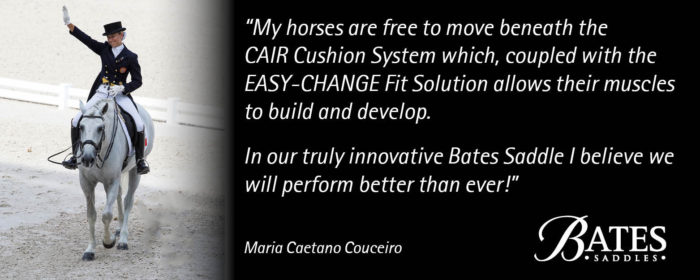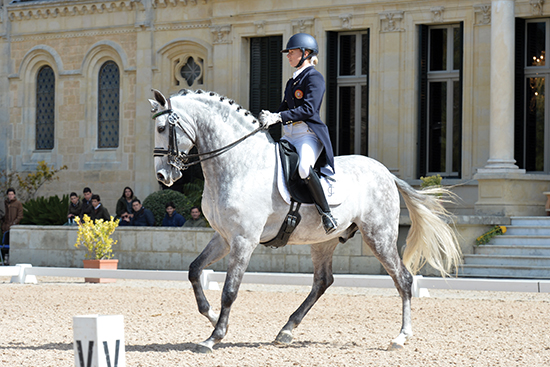 Story by Chris Hector and photos by Roz Neave
Story by Chris Hector and photos by Roz Neave
Maria Caetano Couceiro is one of Portugal’s leading Grand Prix dressage riders. She comes from a distinguished tradition, her father Paulo Caetano is a fine bullfight rider.
I had the privilege of watching him work at home in his little indoor, marveling at the grace and delicacy of the Portuguese tradition at work – but he is equally at home beside a full-sized dressage arena, helping his daughter, Maria warm up for a dressage test.
In an interview with Teresa Burton on EQUILIFE, Paulo explained that his uncle Fernando Metzner Serra, was his first master, when he was four years old.
“His knowledge of riding had a German origin and he shared his knowledge generously with me. What taught me the basics of classical riding was the study of earlier grand masters like Pluvinel, Robichon de La Gueriniére and Baucher. To me, they are the indisputable masters. I have learned all my basic principles from them.”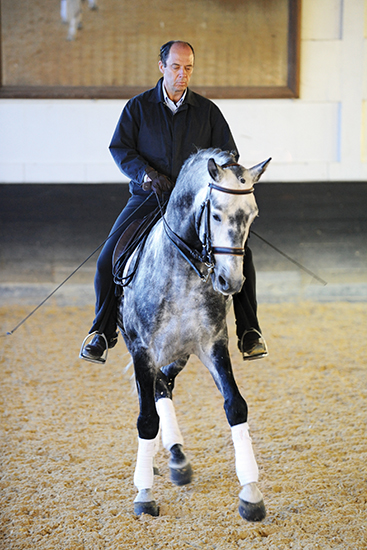
Paulo working in the arena at home
Paulo’s uncle also introduced him to the great masters of that time in Portugal. His uncle was a close friend of João Branco Nuncio and Nuno de Oliveira – the leading icons of classical riding in Portugal.
“My uncle taught me about horse morphology and movements in addition to 18th and 19th-century riding. My father’s friend, the Count da Córte taught me classical training and about the Training Scales for Horses. My father’s other friend João Parreira Cano taught me about dressage as a sport and a discipline. I have always been passionate about the possibility to study and ride with the great masters. I have found out that they have always been open and ready to share their knowledge.”
We caught up with Paulo and Maria at Jerez, where she placed well in the Grand Prix on her stallion, Coroado. Watching Maria work is a delight on both her horses – Coroado, and her ‘pink’ Small Tour horse, Biso Des Lezirias who won the second Prix St Georges and the second Intermediaire I – beating Matthias Rath and the wildly popular Schockemöhle breeding stallion, Foundation, into second on both occasions.It was great to see Maria ride, but interesting to see the Bates logo on her saddlecloth…
How does a Portuguese rider end up riding in an Australian saddle?
“It is a big pleasure to ride in such a good saddle. The contact began in Spain, the Bates representative there contacted me and wanted me to be the Bates advocate in Portugal. It was a pleasure and an honor because I really love the saddles, before they contacted me I had already looked at the saddles and wanted to have one. It’s almost two years now that I have been riding in a Bates Saddle.”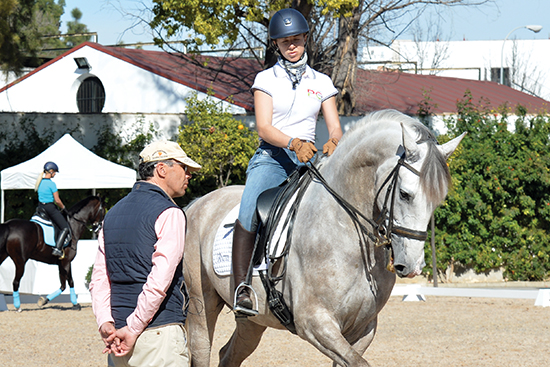
The father/daughter team
You come from an equestrian family, your father is a bull-fighter?
“A horse bull-fighter, that is the traditional way in Portugal. I come from a family that has been involved in horses for a long time, and we have horses in our lives every day. It is easy on one side, but on the other, to have such a ‘heavy’ name in Portugal, is also sometimes difficult because people expect a lot from me. But I can do it because my father helps me a lot, and it is very easy to work each day with him.”
Did you ever go in a bull-fight yourself?
“No, not in a professional way. At home in the training with my father, and my brother is also a bull-fighter, sometimes I try, but it only for fun.”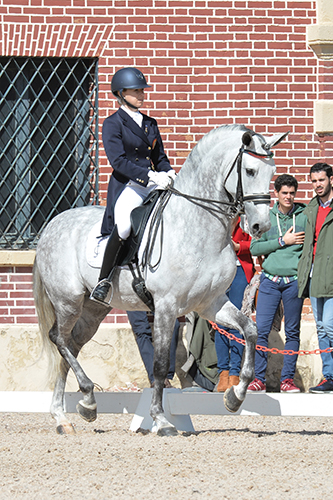
Coroado – the young Grand Prix stallion
Was it hard making the transition – it is a different style of riding in the traditional little indoor schools, to the competition sixty by twenty arena?
“No, because my father is a bull-fighter, but he has always been passionate for dressage and his masters in the past, they were all dressage masters. Besides the bull-fight, we were all connected to dressage and the classic style of riding. In the end, to prepare and train a horse for a bull-fight, the basic work is the same as for dressage. It is just then adapting at the end, but the high level of the gymnastics and the classical training is the same.”
This is perhaps best illustrated by a story Paulo told EQUILIFE:
“My daughter, Maria was to compete in her second European Championships as a young rider. Those days she rode Warmblood horses, and her horse White Cedar was on his way to Austria for the championships. Then a friend of hers asked her if she wanted to ride a Prix St. Georges-class here at home. Maria turned to me. ‘Dad, I have a problem. I really want to do this, but I have no horse here.’ ‘No problem’, I said. ‘Take one of mine.’”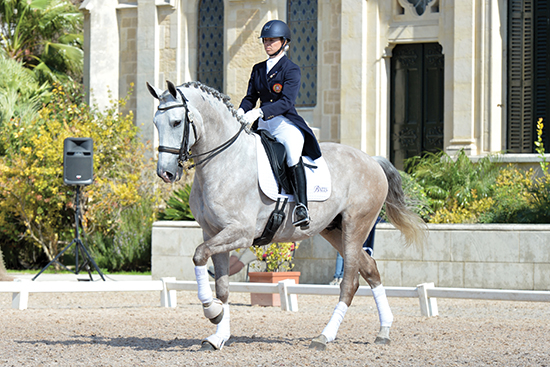
Biso Des Lezirias – winning at the Prix St Georges
“No sooner said than done. She trained a Lusitano horse for some days, and then she performed a nice Prix St. Georges. What nobody knew, was that I rode the same horse the next day in an important bullfight. He was one of my best horses. This shows how important basic classical training is. Another horse, Sole Sombra, had such a solid and elementary education of classical riding that I only needed two weeks training to get him ready for the bullfights. We performed very well together. A month later I sold him to a German dressage rider. What a horse!”
If you liked this article you may be interested in:
The Horses of Portugal – Part 1 – The Royal School of Lisbon
The Horses of Portugal – Part 3 – Working Equitation & Competition Dressage

